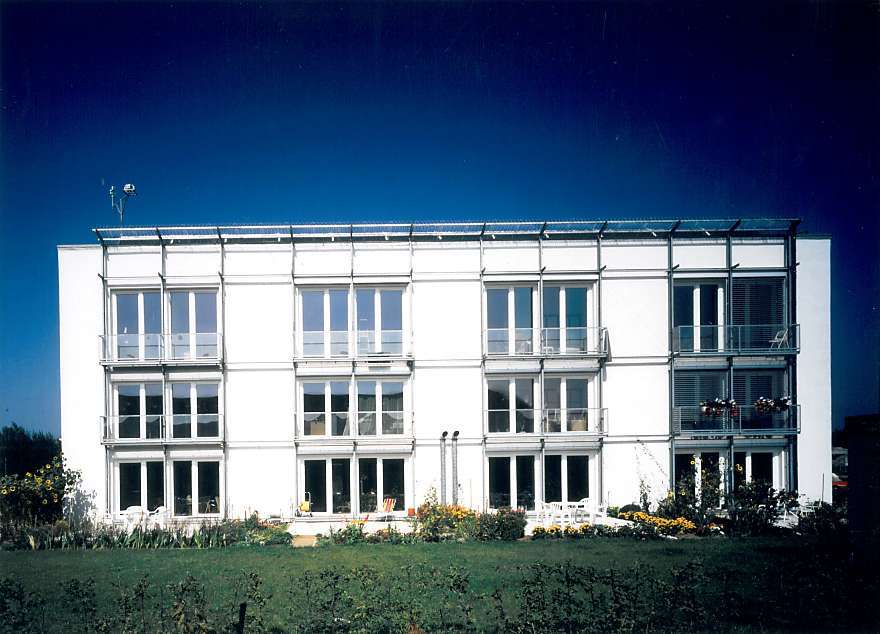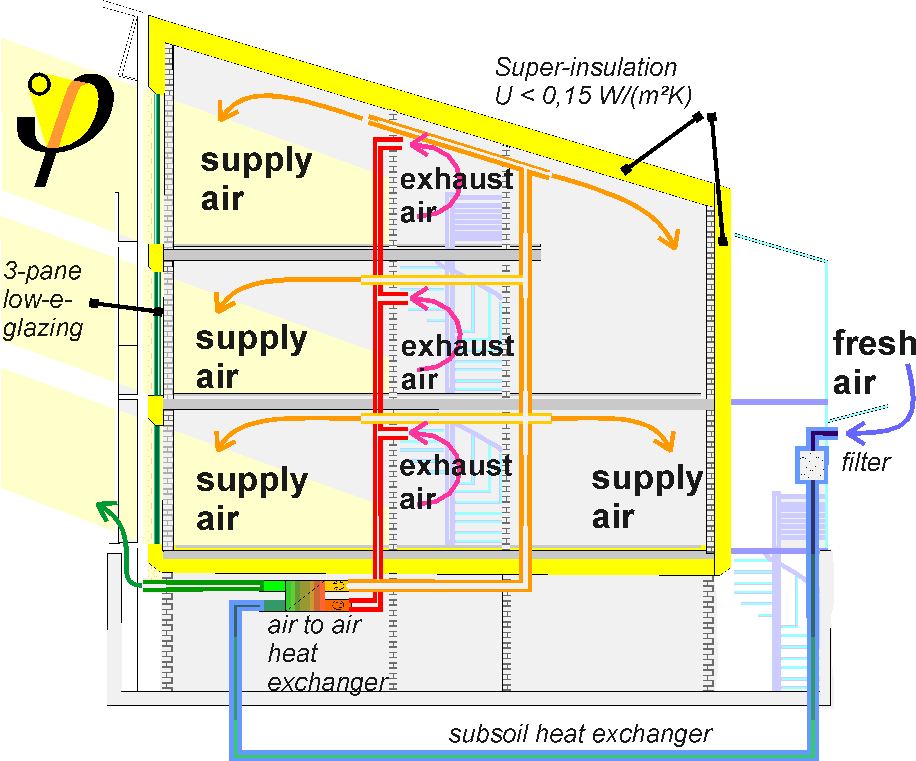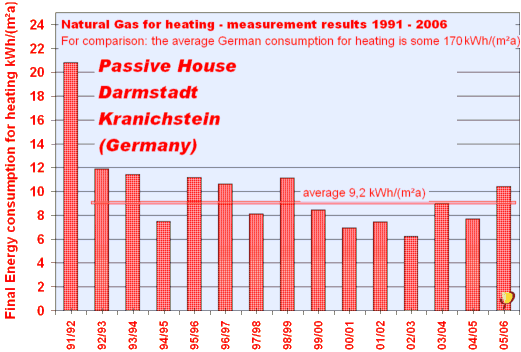| The
Passive House in Darmstadt - Kranichstein during Spring, Summer, Autumn and Winter |
by Dr. Wolfgang Feist, Passive House Institute, 2006
The Passive House in Darmstadt Kranichstein has been constructed in 1990/91 on design plans by architects Prof. Bott/Ridder/Westermeyer for four private clients. The following photographies show the building during the seasons and there are some comments added what it feels like to live in this building at the season given. A description of the building and the scientific background you will find here (German site).
Spring
at last! In 2006 it took a long time. But: In this Passive
House we did not have to use the heating system since March 15th (to have
something to compare, in the German Climate heating is needed normally
until the mid of May). And the windows may be opened in our Passive House
whenever we want, e.g. to hear the birds sing in the morning (see:
What about opening windows in a Passive House? (German)). This building
keeps warm by itself during March. On the other hand, we can leave the
windows closed, too, if we want: A sufficient amount of fresh air always
is guaranteed by the ventilation system. There can not be bad air quality
in this house, even if you keep the windows closed for several days long.
In the photography you can see the exhaust air outlet of the Eastern dwelling
(at mid bottom of the gable wall). The two outlets of the mid dwellings
can be seen just glimpsing through the fine new green of the shrub mid
of the Southern facade.
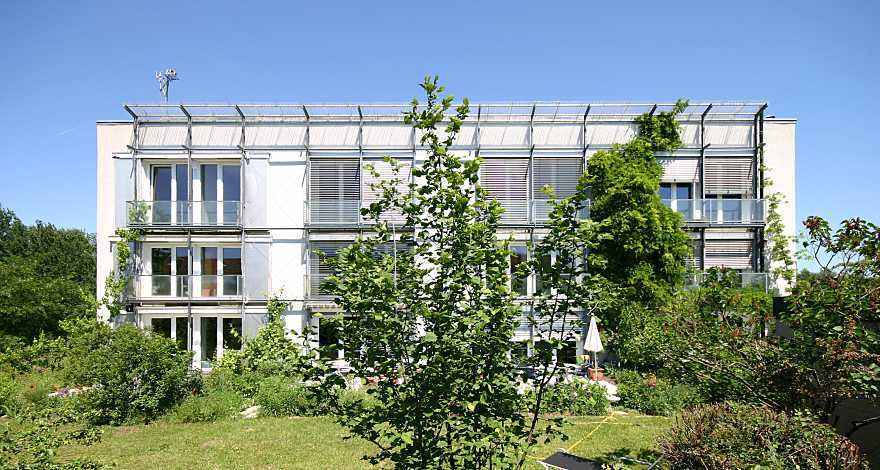
During
Summer the wild wine spends shadow - and the Venetian
blinds, which will be closed quite often. The dwelling to the left does
not have Venetian blinds, but insulated gliding shutters. Early in the
morning it is still cool outside and we can ventilate the dwellings by
opening the windows. Even during the extremely hot European Summer in
2003 we were able to keep our Passive House cool without a cooling system
(without active air conditioning) - the same was true during the hottest
month ever measured sofar in Germany, July 2006. That was far more diffucult
in the office rooms rented by the Passive House Institute, which are not
insulted very well. The long time constant of the Passive House allow
for keeping the cool indoor conditions for a quite long time.
This
is an image taken by the professional photographer H. G. Esch from early
times (1992) showing the Southern facade of the Passive House in Darmstadt
Kranichstein later in the Summer. At this early times the gliding insulating
shutters of the western dwelling (left) had not been installed and the
wine had not yet grown (click on the image to get a higher resolution;
152 kB). Measurements dating from 1991/92 even show, that in spite of
the insufficient shading comfortable conditions had been kept for indoor
climate. There are four reasons for that: The very good conditions for
night ventilation by opening the windows in different floors of the dwelling,
the orientation of the facade exactly to the South (there is not a lot
of solar radiation available during Summer on vertical South orientated
surfaces in this geographic latitude), the small, but during Summer efficient
shading by the lintels of the windows and the small balconies and the
long time constant of the building.
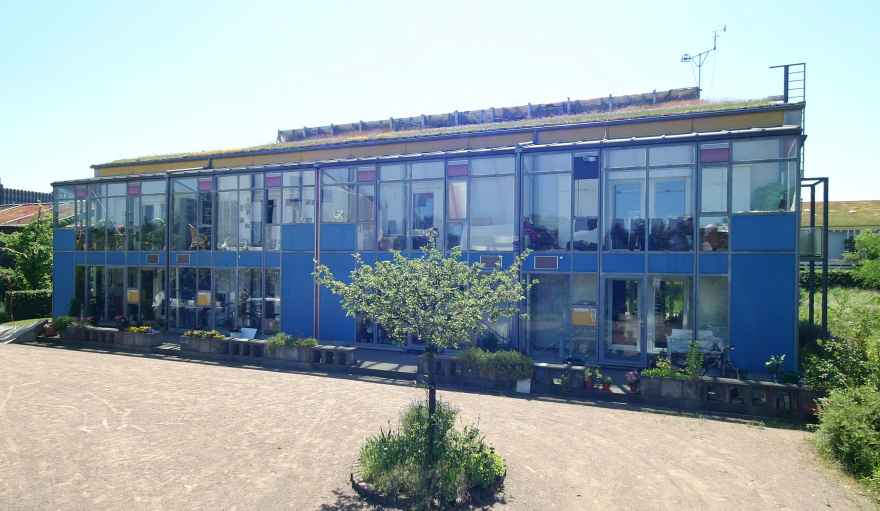
This
is a snapshot of the Northern facade of the Passive Houses (June 2006).
The big glazed space at the Northern part is not important for the energy
balances - its an architectural feature. From the glazed space there is
access to each individual rooms in the basement. All four fresh air inlets
can be seen in this image in height of the ground floor ceilings. Behind
the inlet grid there is back-to-back the highly efficient air filter (F8).
The air ducts have proven to be absolutely clean even after a time of
15 years - of course these ducts were carefully sealed to be airtight
from the beginning.
The
blaze of colour during autumn.
This image was taken 8th of November - it still will be a long time, before
the heating will have to be activated in the dwellings. But it is comfortable
warm in the house (between 21 and 23°C) and from time to time windows
will still be opened. In the image you can see, that even some Venetian
blinds are still closed: Not any quanta of solar energy is absolutely
needed at this time, the home keeps warm, anyhow. As a roule somewhen
in December the central gas fired heating system is switched to "Winter-mode",
depending on weather-conditions. There were years with no need to start
heating earlier than Christmas day. At any sunny day the radiation shines
deep inside the rooms. During the day the house may warm up to 23 °C;
during a sunny day late in autumn the average temperature may rise by
1 degree (Celsius). But, in this climate, unfortunatedly beginning mid
of December cloudy conditions prevail. Without direct sun the house "loses"
in a 24 hour period some 0,1 up to 0,2 °C, depending on outside temperature.
Therefore it takes some time until the losses consumed the stored internal
energy - and the heating has to be activated.
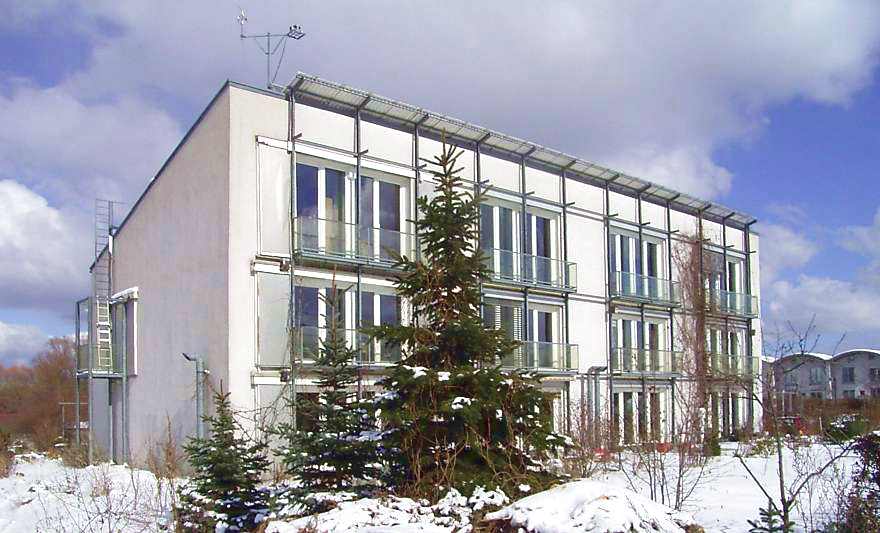
Not very often there was such a big amount of snow in Darmstadt, like we had had in Winter 2005/2006. But in January 2005 there was snow, too (Image: W. Ebel). During such cold weather we are very happy to have a ventilation system delivering fresh air and keeping a good indoor air quality without a need to open the windows. The earth burried tubes and the heat recovery of the ventilation system keep the temperature of the fresh air entering the room to be higher than 18 °C. The air inlets are positioned near to the ceiling of the rooms. The air has already mixed up with room air before it enters the living space. To deliver space heating, in this building small radiators placed at internal walls are used. That can be done in a Passive House, because all indoor surfaces, especially those of the windows, are comfortable warm. The surfaces do not lose a lot of heat, and the envelope is really airtight, all this together guarantees that there are no cold drafts in this building.
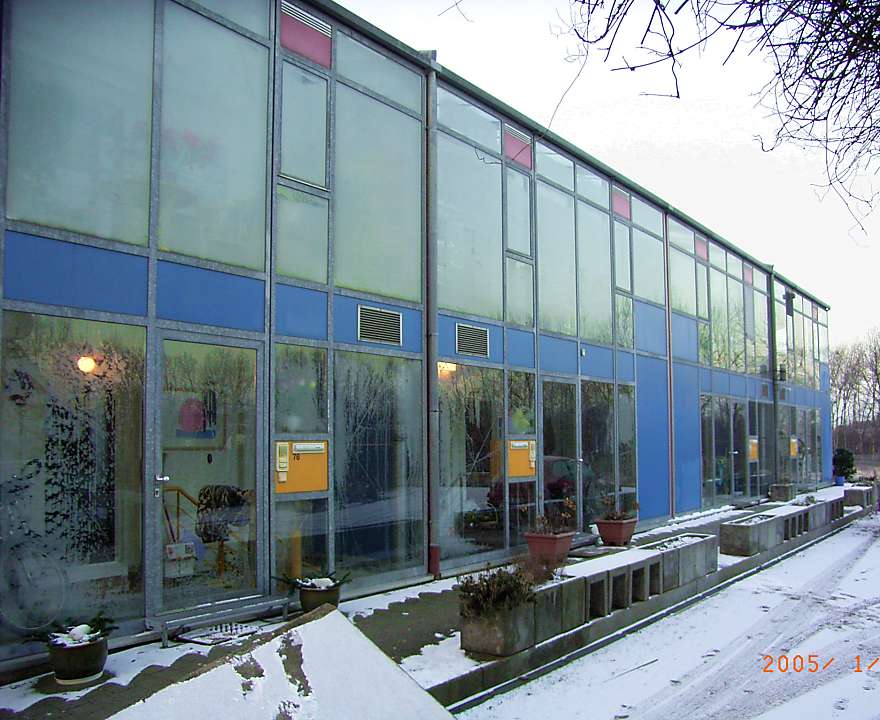
The Northern part of the Passive House in Darmstadt Kranichstein has a spacious glazed space, which is not heated. There are only single pane windows used - during frost there will be frost patterns on the panes. A splendid example is shown in the next image. In the image above the fresh air inlets in a height of 2.80 m can be seen.
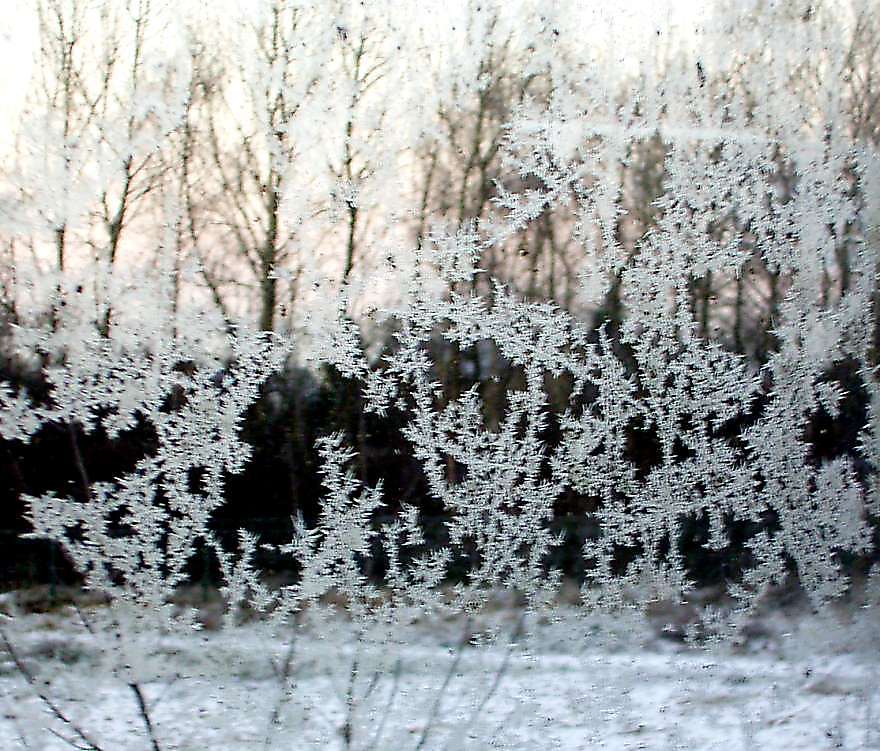
Frost patterns at the interior surface of the single pane glazings in the Northern glazed space of the passive house. Children still can experience this phenomenon of nature - without uncomfortbale cold conditions in the living space. The thermal envelope of the house is the northern separation wall to the glazed space (see the section shown below). There are big triple glazed windows in that wall and the wall is insulated almost at the same level (namely 27.5 cm) as all the other external walls. Therefore it is cold during winter in the glazed space.
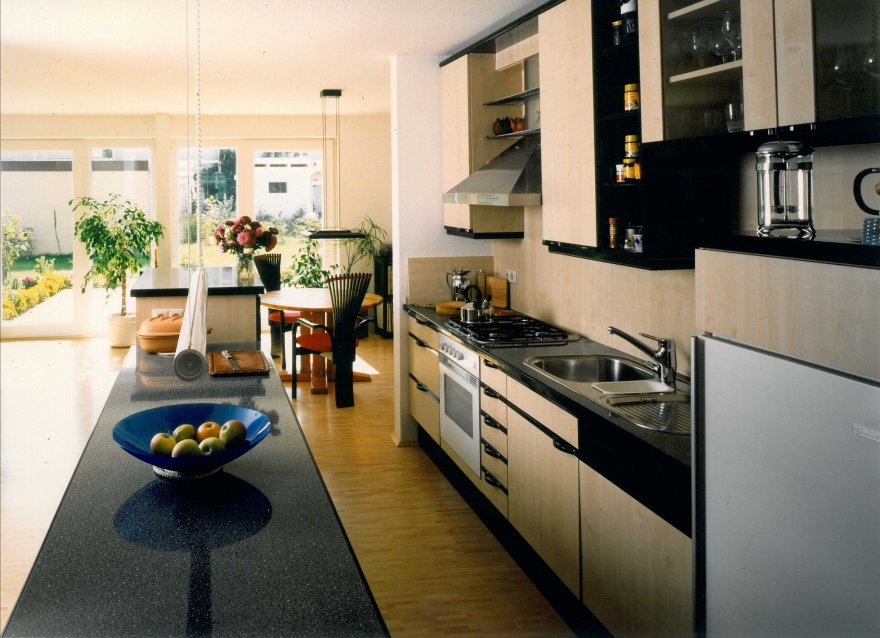
An interior
view of a spacious living area in the ground floor of the Passive House
at Darmstadt Kranichstein (Photo: HG Esch).
This is a section through the Passive House Darmstadt Kranchstein showing the most important essentials:
- There is a very good thermal insulation all around the heated space (in the roof 450, on the external walls 275 and beyond the basement ceiling 250 mm of thermal insulation).
- Triple pane windows with a special insulation of the window frames (built by handicraft work) have been used. Nowadays these Passive House windows are available on the market, at least in Europe.
- The fresh air ventilation system with the air inlet at the Northern facade, filter, earth burried ducts to preheat the fresh air ("subsoil heat exchanger"), air-to-air heat exchanger in the beasement and supply ductwork (the duct system is simplified compared to the house actually built. In new Passive Houses it will be designed in the way shown here).
All this works as designed unchanged since 15 years of operation.
The diagram illustrates the consumption of natural gas for heating all
four dwellings during the last 15 years. The consumption is divided by
the living space, which is 156 m² in each dwelling. The consumption
was somewhat higher during the first heating period (far to the left).
This was not only due to extra heat needed to dry out humidity from the
construction process (on site concrete floors) and to heat up the whole
construction in an unfortunatedly cold October, but also to the fact that
some details were not completed before Summer 1992, e.g. the extra insulation
of the window frames. Beginning 1992, the consumption was stable at an
average of some 9 kWh/(m²a). That gives, compared to an average German
consumption for heating of some 170 kWh/(m²a) an reduction of the
energy consumed by 95%. This is almost a factor 20 in
efficiency. Building Passive Houses, the energy demand for heating will
not be important any more - this extraordinary small demand will be available
from natural ressources within the region at any future time.
It is no exaggeration to claim that this is a solution for the mitigation of climate change. Notice, that there are no limits for the living space in a Passive House - there is no need to waive the way of living, to reduce living space ore to restrict comfort. But, of course, it will be necessary to change the way of construction at some details: There is a need for better insulation, for heat recovery, better windows, ... All this can be made available from regional ressources at any country and can be realized by local craftsmen. And, yes, there is a need for postgraduate professional education for these craftsmen.
The extraordinary low heat consumption is realized not by reducing comfort, on the contrary, the indoor temperatures are very comfortable all the time. There are no drafts, there is no noise, there is a very healthy indoor climate all the time. The energy conservation is realized by improving the quality of the buildings thermal envelope: By very good insulation, by triple pane windows and by heat recovery from the exhaust air. After a period of now 15 years the building materials, windows, ventilation systems etc. are available on the market, beeing produced by some hundreds of enterprises in Europe. The concept has been copied a thousand of times - always successfully (for more examples see Built Passive House Projects). The concept is free and the design principles have been published.
Saving energy by using highly efficient innovative technologies is not restricted to the heating of buildings. The same principle holds for cars, fridges, washing mashines and almost everything consuming energy. See our page on energy efficiency.
You will find further results here: 15 Years Passive House Kranichstein (German).
Further
information available at the Passive
House Institute. An introduction to the scientific background, the
design and the experiences with Passive Houses you will find in the internet
at the pages of the International
Conferences on Passive Houses: Use the link to "Passive
House".
Author: Dr. Wolfgang Feist, Passive House Institute, Darmstadt, Germany
